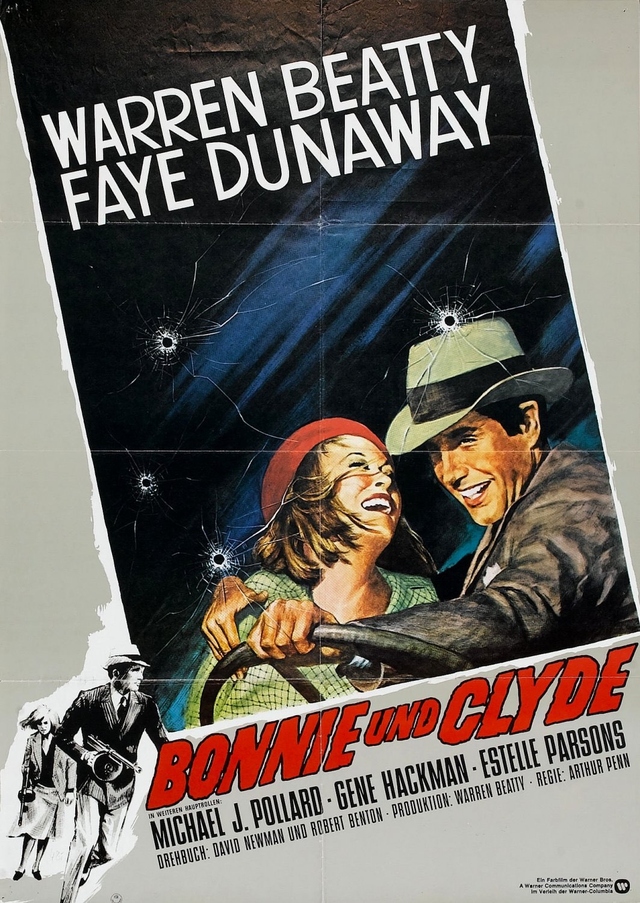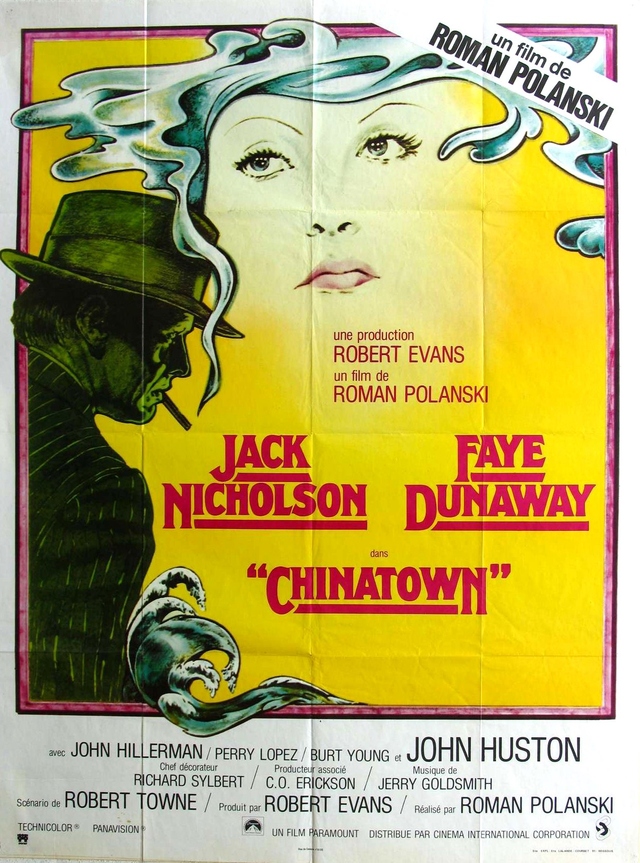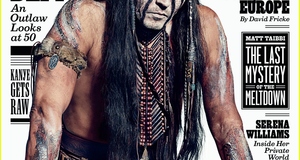Living with Evil: Crime and Sexuality in Bonnie and Clyde and Chinatown
By
2015, Vol. 7 No. 03 | pg. 1/2 | »
KEYWORDS:
Through the late 1960s the French New Wave became a pronounced and significant factor in the creation and development of Hollywood films. Such movements had gained popularity through an ability to engage with a younger audience by means of a more youthful focus, by taking advantage of a counterculture brought about by the disillusionment with hierarchy exemplified by protests against the Vietnam War, political assassinations, experimentation with drugs, gay liberation and a rise in sexual freedom. Partly in an attempt to take advantage of this, but also encouraged by favourable taxation on filmmaking prior to 1976, the studios funded young, college educated filmmakers to create youth orientated pictures. Crime becomes not immoral in this era, but a sexualised, exotic rebellion. These brought to the screen modernist techniques, novel narrative structures, and storylines which, in previous eras, would have been restricted by the production code or not pursued at all because of conservative audiences. Films of this period also placed the relationship between crime and sexuality into a new context, reflecting a change in accordance with the growing apathy toward the former and the liberal embrace of the latter. 
Movie posters from Bonnie and Clyde and Chinatown, which were popular in movie theaters around the world. Characterising the American film renaissance and the merging of Hollywood with a European style of filmmaking was Arthur Penn’s Bonnie and Clyde (1967). Here, sexuality is used as a tool to express the sense of escapism achieved through crime, and as a means in itself to perforate the mundane. In contrast, Roman Polanski’s Chinatown (1974) depicts solving crime as a means of finding answers in an overwhelming world, and sexuality, or rather sex, as a tool of oppression and corruption. This is most obvious in Noah Cross fathering his daughter’s child, but also in Jake Gettes’ Oedipal journey. Both Penn and Polanski also portray crime as nearly inconsequential next to individual evil. A conspiracy to divert a water supply, even one supplemented by murder, doesn’t make much of a moral dent once Catherine’s true identity is revealed, while the murders and robberies of Bonnie and Clyde are overwhelmed by the romanticism and brutality of their own deaths. Consequently, Chinatown and Bonnie and Clyde, both quintessentially tragedies, challenge perceptions of what comprises criminality, especially in relation to individual evil, and construct sexuality and crime as tools of escapism, corruption and oppression. In Bonnie and Clyde, crime and sex are methods of achieving escape. Bonnie, from her nude introduction, to her suggestive drinking of the bottle of coke and delicate grasping of Clyde’s obviously phallic gun, presents herself as a deeply sexualised character. She is attracted to the criminality of Clyde and the adventurous implications of running from the law. Here, therefore, crime provides an exoticism, a means by which to escape the mundane and seek stimulation. Penn saw Bonnie as “a woman with an enormous appetite that was going ungratified - an appetite for identity, for sex, for contact with someone who brings with him an air of the exotic, something outside her tiny little town and tiny little job as a waitress” (Macnab, 58-9). Bonnie turns to crime because she finds her attempts to fill this appetite for the exotic by way of sex unsuccessful, through previous, implied encounters, but also with Clyde. Paradoxically, despite the excitement provided by crime “The only reaction to this excitement that is available to Bonnie is sexual, the means by which her ego expresses itself” (Blum, 29). Consequently, even in the thrill of being pursued, Bonnie seeks sex and an emotional connection with Clyde. Contrary to Bonnie, in Chinatown Evelyn’s sexuality serves to entrap her and foreshadow her death. Stephen Cooper argues that “the detective in fact does align himself implicitly with the very forces of repressive power against which he struggles (to struggle), and in so doing ultimately victimizes the women he investigates/works for/loves” (24). Here, Cooper is articulating that in the moment Gettes has sex with Evelyn, he aligns her journey with that of the last women he failed to protect in Chinatown. By making her the romantic interest of the protagonist in detective movies, Gettes is confirming her generic obligation to be tragically killed. Furthermore, he notices the flaw in her iris- the ominous birthmark which is ultimately pierced by a bullet- immediately before they have sex. Therefore Evelyn’s sexual association with Gettes, and his professional commitment and personal compulsion to solve crime, condemns her. If the sexuality of Bonnie initially complicates her full engagement with the rebellious freedom of a road movie, Evelyn’s sexuality, and her relations with Gettes, confirms her entrapment in ‘Chinatown’: the corrupt, criminal world of the Film Noir detective. The dark, dishonest world of Chinatown reflects a popular contemporary view of the establishment as an insular body operating above personal and liberal freedoms. The emergence of the Watergate Scandal in 1972, the ongoing Vietnam War and the associated atrocities, corruption and democratic anomalies distanced the public, especially the booming youth population, from their elected representatives. Gittes asking Cross “What can you buy that you can’t already afford?” (Chinatown) underlines the sense of pointlessness that surrounded political transgressions in this period. Arthur Penn recalls that “a similar resistance was expressed in another form by middle-class people in the 60s” to the “young, bucolic bumpkins who took on the banks, which were perceived as the social enemy.” Therefore his title characters, ordained through Bonnie’s poem as mythically embodying this “cause of the dispossessed” (Bernstein, 24), reflect the society they predated by thirty years due to their desire to reclaim personal freedom and be more than the situation they were born into. Bonnie is allowed to find crime adventurous and Clyde sexually attractive- yet remain engaged with the audience- because the idea of crime was belittled by the weariness the public felt with the law, after all, “Society murdered St. Joan, too” (Blum, 30). Chinatown reflects this weariness as its protagonist is unable to win, despite solving the case. Gettes knows Cross killed Mulwray, he works out the conspiracy and yet it all means nothing as Cross “owns the police” (Chinatown) and is able to escape justice and recover Catherine. Such a situation draws comparisons to Richard Nixon during the Watergate Scandal, and his pardoning by Gerald Ford afterwards, in so much as a solved case doesn’t necessarily instigate justice. In the final sequence, the frustration of a scene dripping with political and moral corruption is contrasted with the almost sickening sight of Cross, with no reaction from the police or Gettes, leading the screaming Catherine away from her dead mother; the reminder that his use of sexuality transcended the crime of the film through an individual act of evil. American cinema in this era acted to question the perception and definition of crime and criminality. Michel Foucault theorised that human consciousness was shaped and defined by historical and social context; that the codification and classification of behaviour varied through time. The concept of crime, like all concepts to Foucault, becomes changeable. As a result, the morality of stealing, murder, corruption and violence is relevant only to the culture in which it is taking place. Similarities between the social problems of the late 1960s and the economics of the Depression era, allows robbing banks to be interpreted as an attack on the capitalist forces of social oppression. Corruption, however, is more relatable to contemporary crimes against the wider population and innocent individuals, limiting the empathy felt for its perpetrators. If power is perceived to have been derived from discourse, then an act of rebellion draws sympathy rather than criticism. If the audience interprets Clyde and Bonnie’s ‘criminality’ as a rejection of this discourse and an attempt to embrace the liberal freedoms from which they have been deprived, then their actions become a form of expression; an exotic, adventurous release to which the audience can aspire and relate. Moreover, this sympathy, along with Penn’s romanticised direction, pushes criminality away from the title characters, and on to those by whom they are brutally killed. Even without a Foucauldian perception of crime seated in the context of 1960s political apathy, Penn’s direction creates an inescapable sympathy for the bullet-ridden duo. The overt quantity of ammunition, piercing already lifeless bodies, coupled with the morality of trapping people who weren’t warned, armed or subject to trial, gives the audience a sense of pity and almost guilt- Bonnie and Clyde are relatable, but the law is part of a society that the audience actively engages in. The brutality of the scene, enhanced by the slow motion and the knowing, loving final look they give one another, leaves the audience not only querying crime, but struggling to understand their own system of justice. Bank robbers being ambushed on roadsides may have been all but consigned to history by 1967, but death by force without trial certainly was not.Continued on Next Page » Suggested Reading from Inquiries Journal
Inquiries Journal provides undergraduate and graduate students around the world a platform for the wide dissemination of academic work over a range of core disciplines. Representing the work of students from hundreds of institutions around the globe, Inquiries Journal's large database of academic articles is completely free. Learn more | Blog | Submit Latest in Film & Media |

















